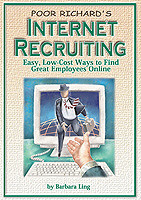Poor Richard’s Internet Recruiting, Barbara Ling, Top Floor Publishing, 2001, ISBN 1930082010.
 Reviewed by Jean Hollis Weber
Reviewed by Jean Hollis Weber
This book is filled with useful information, but it needs a good editor to cut out a lot of the repetition and generally tighten it up. That complaint aside, the value of the contents is high enough that I recommend you give this book to people in your company, or to your clients, who are using or planning to use the Internet as a recruiting medium.
Chances are they, and you, are aware of only a subset of the different ways to get the most from the Internet, in the most cost-effective way, though you’re aware of many ways that are not a good idea (such as “spam”). I certainly learnt a lot by reading the book.
Barbara Ling starts with the question that everyone should ask, but many people don’t: is Internet recruiting for you? She presents a quick overview of the pros and cons, helps readers to know their goals, and summarises the rules of netiquette.
She then moves on to an overview of the tools you need and the necessity for determining who will do what. For example, if you’re expecting that whoever currently does recruiting in your company will also handle Internet recruiting, you need to make sure they have the appropriate skills. If you want to automate some aspects of the recruitment process (such as sending an autoresponse to applicants, saying that you’re received their resumes), who will handle that? Do they know how? Will you need some technical assistance?
Next the author looks at some recuitment issues that would apply no matter how you are looking for applicants: determining the characteristics of your ideal employee and writing a winning advertisement.
The next step is to decide where and how to place your ads. This is where the Internet can be different from print advertising: in addition to putting ads on job boards and other places (for which you usually have to pay), you can post on relevant newsgroups and lists (if they allow job notices); you can have a careers section on your own company website; and you can include your recruiting efforts in a general company and product awareness and sales campaign on the Internet.
The author gets into ideas that many people either aren’t aware of, or haven’t integrated into their overall Internet marketing strategy. All the ways of marketing and promoting a company on the Internet can reach potential employees as well as potential customers. The author offers techniques that are inexpensive, creative, and easy to implement.
Employees in many industries actively seek out and research companies within those industries, often by visiting their websites. The author presents several ideas for maximising these visits by incorporating candidate resources, descriptions of company benefits, and job postings into your company’s website.
You can use search engines to locate people seeking employment in your industry, because most people post their resumes on their personal websites as well as sending them to job boards. Learn how to find and take advantage of industry niche sites, professional organisations, mailing lists, universities, regional job sites, user groups and more.
Finding people online is just part of the recruitment process. Ling also explains how to review the resumes you receive and how to check on a potential employee’s background by using Web-based testing, quizzes, and comments from past employers.
The book finishes with a chapter on the benefits of using specialist recruiters, including how to choose and brief a recruiter, and an appendix of Internet resources for recruiters.
Barbara Ling is a leading trainer in the Internet recruiting field. In addition to Poor Richard’s Internet Recruiting, she has written The Internet Recruiting Edge, The Real Estate Pro’s Internet Edge, and The Internet Marketing Edge (all appear to no longer be available). She has worked as an Internet consultant, Unix systems administrator, and systems engineer at firms like AT&T, Lucent and IBM. She was spotlighted by Microsoft as their Small Business Success Story in June of 1999.
Although some of the how-to details in the book are a bit dated, the principles are still valid and important. Overall, this book is a good resource that could save many managers and recruiters time and money. Order from resellers at Amazon.com.
Last updated 1 October 2007.
